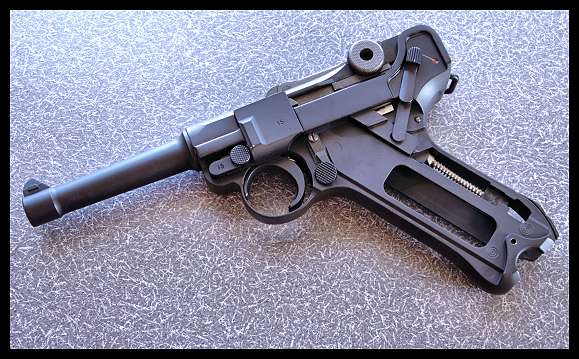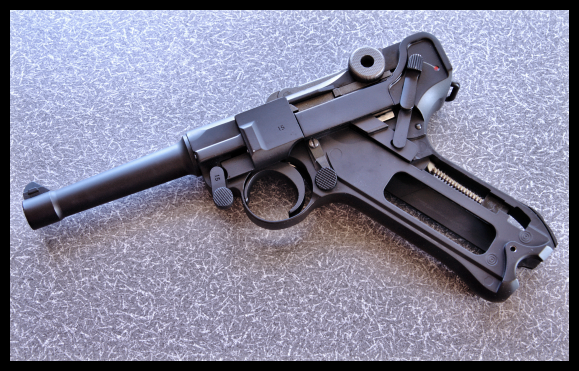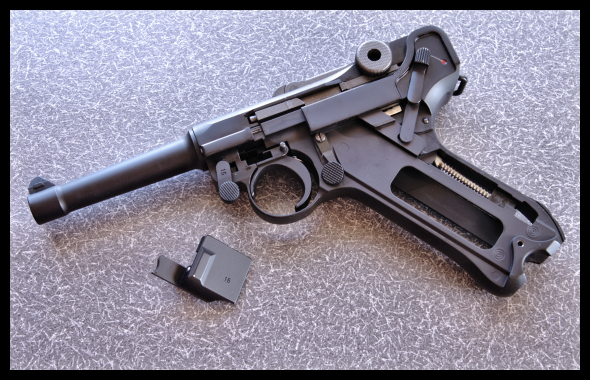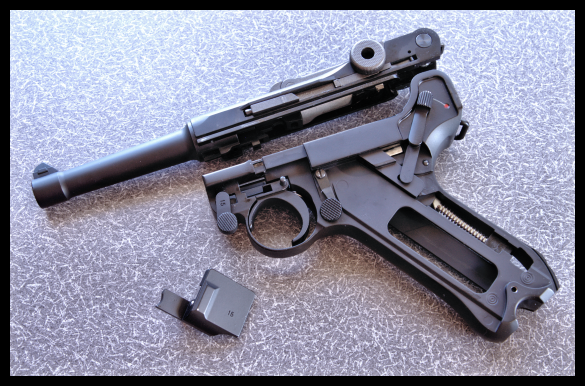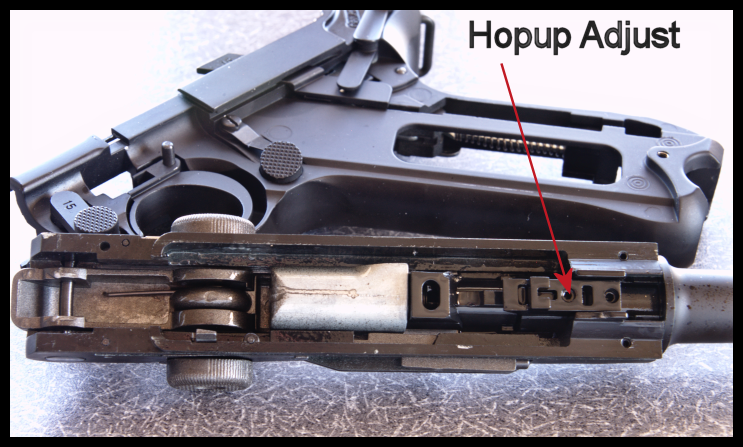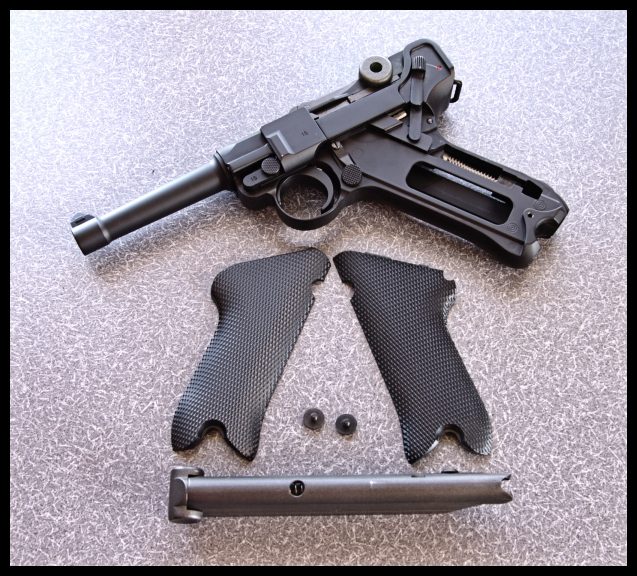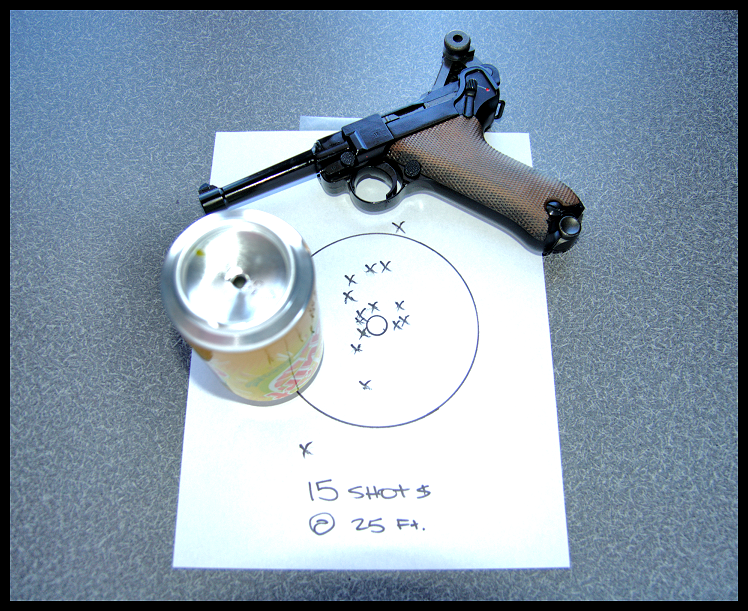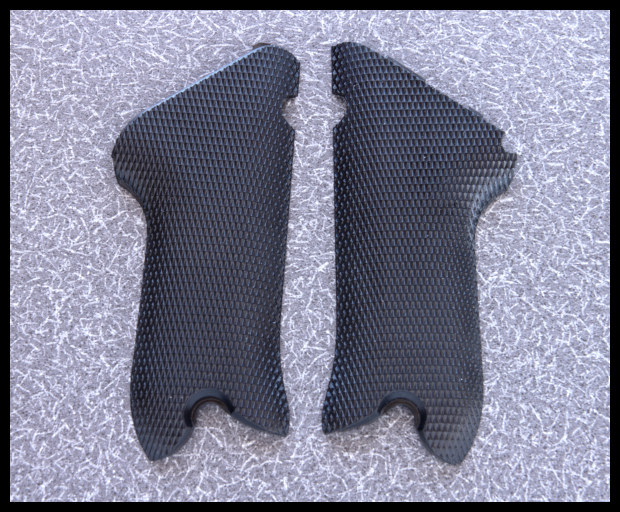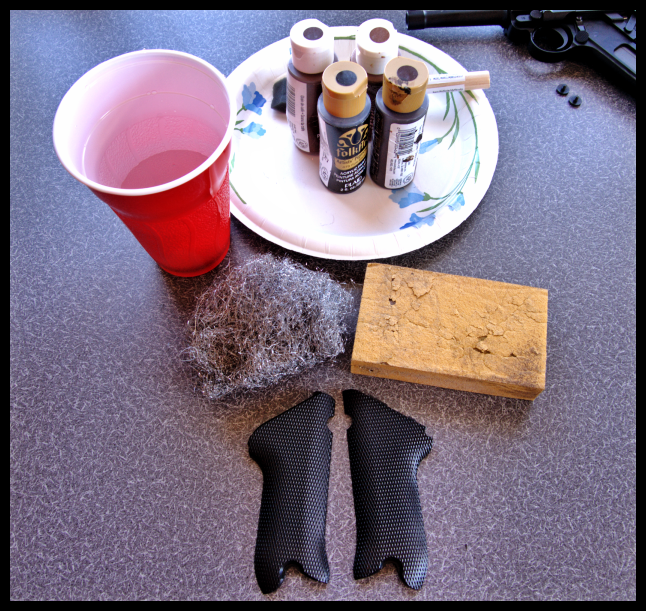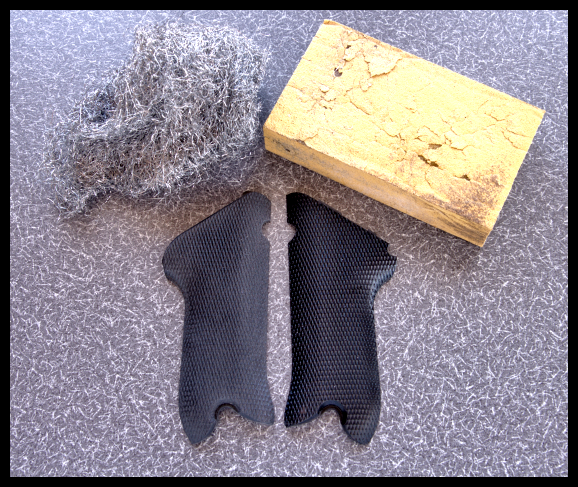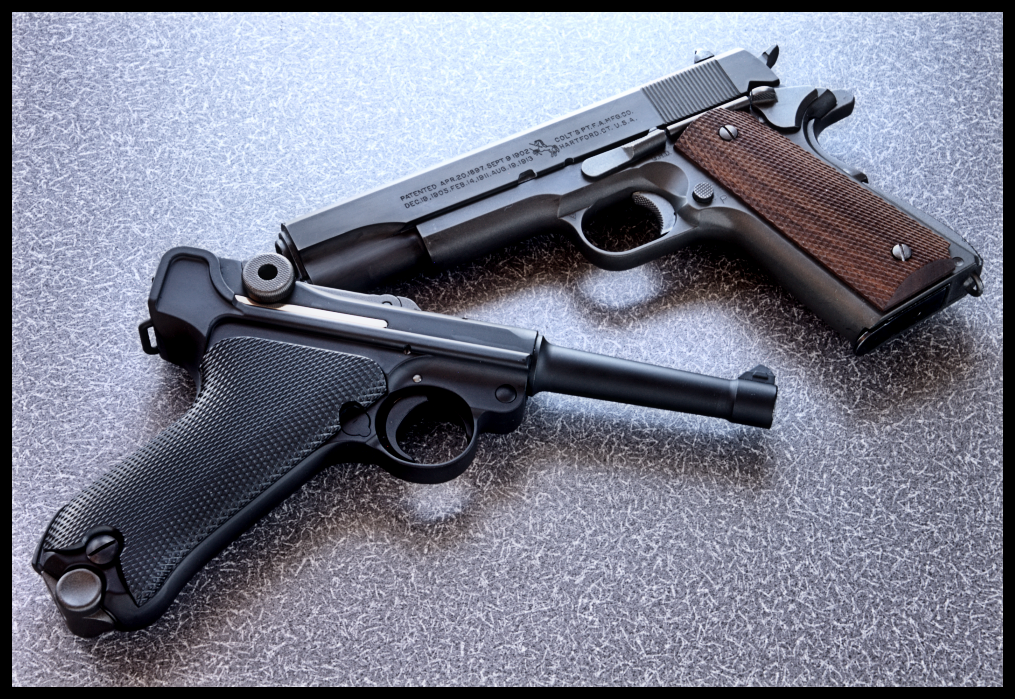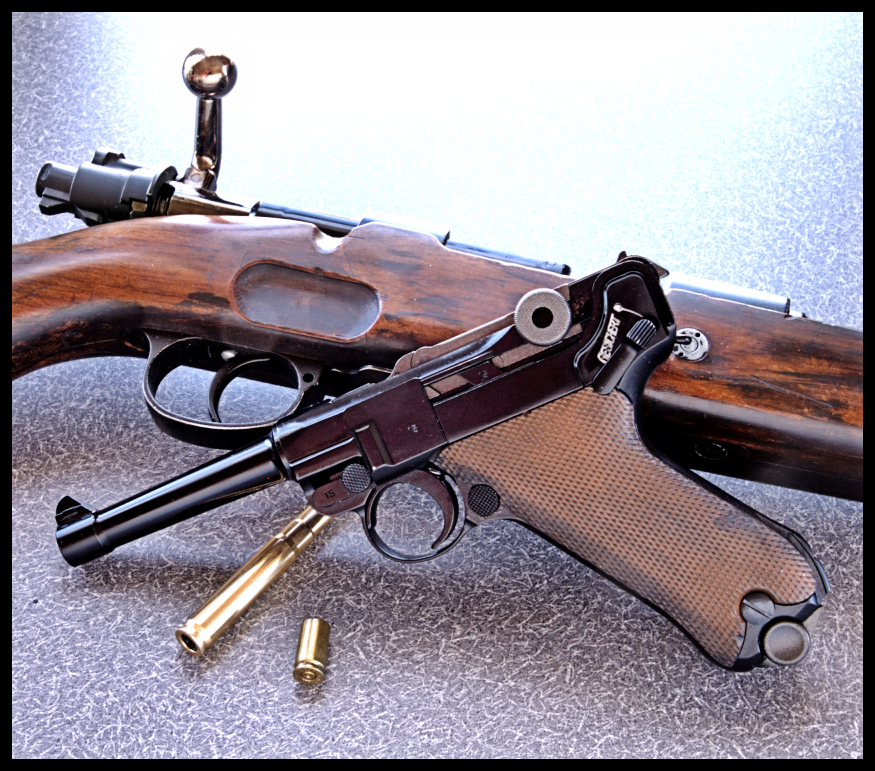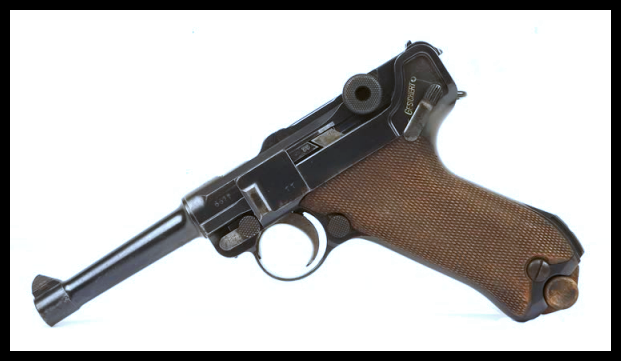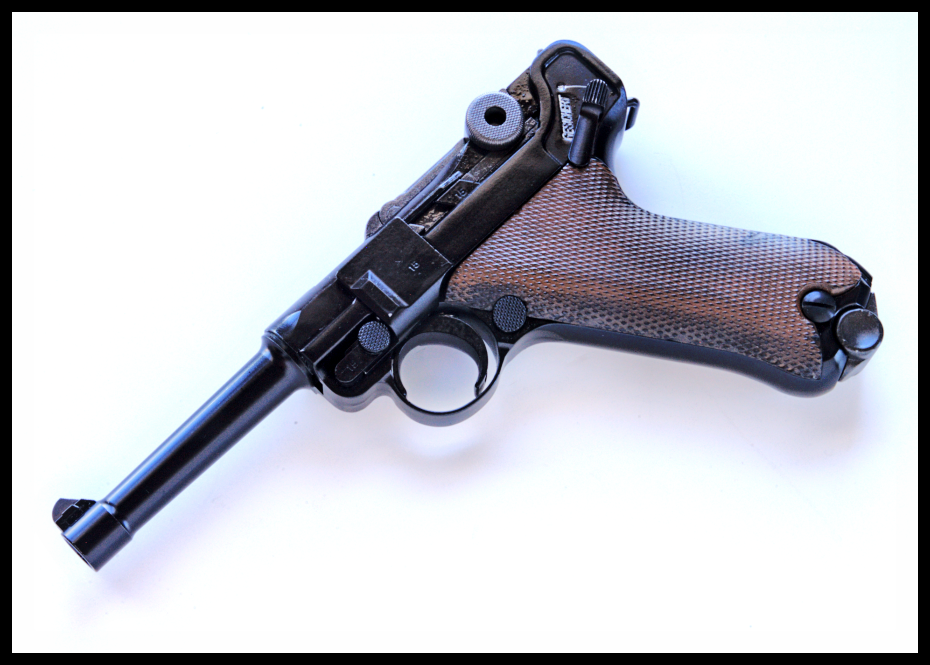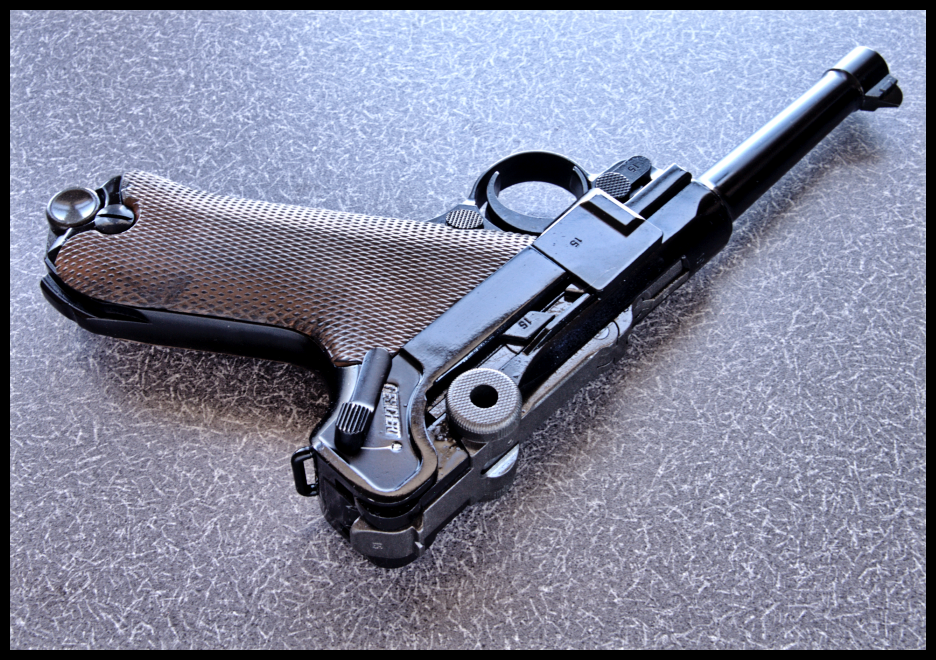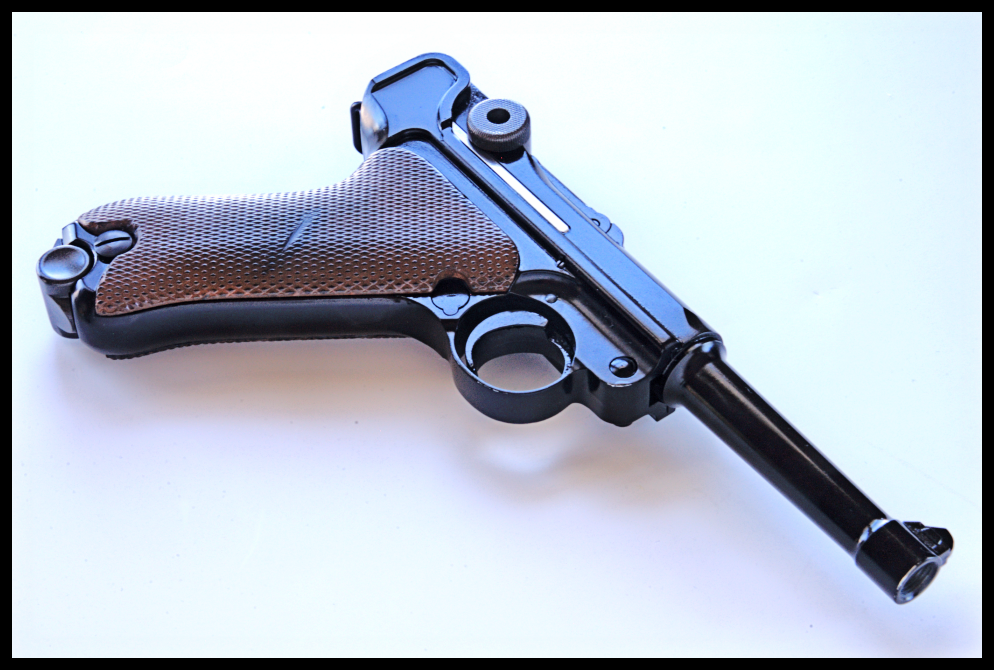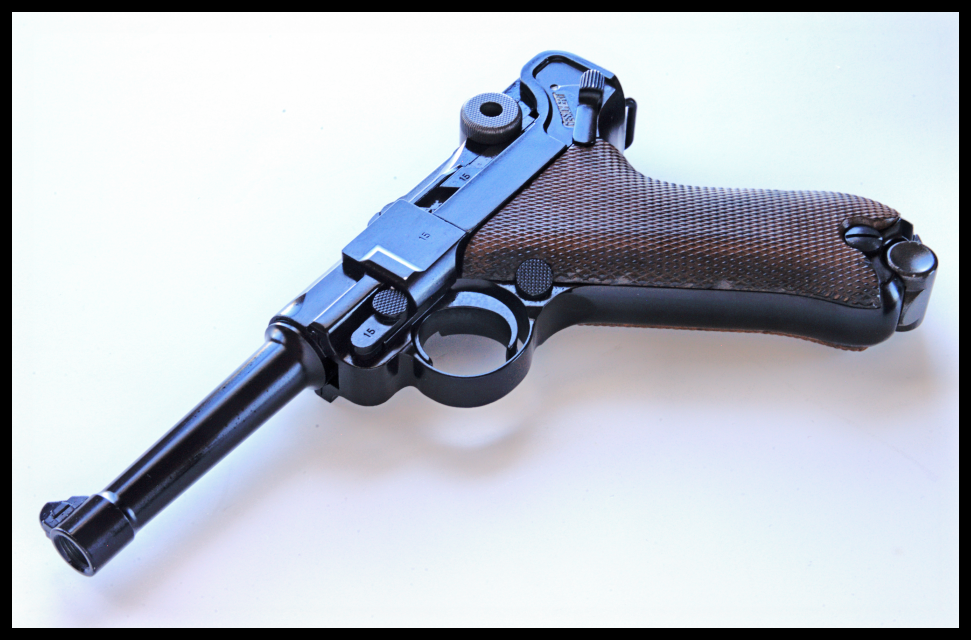Post by Guinness on Jan 27, 2008 12:49:46 GMT -5
WE P08 Luger
-4" Model-
Full Metal GBB
First Impressions and Short Review
[/i][/center]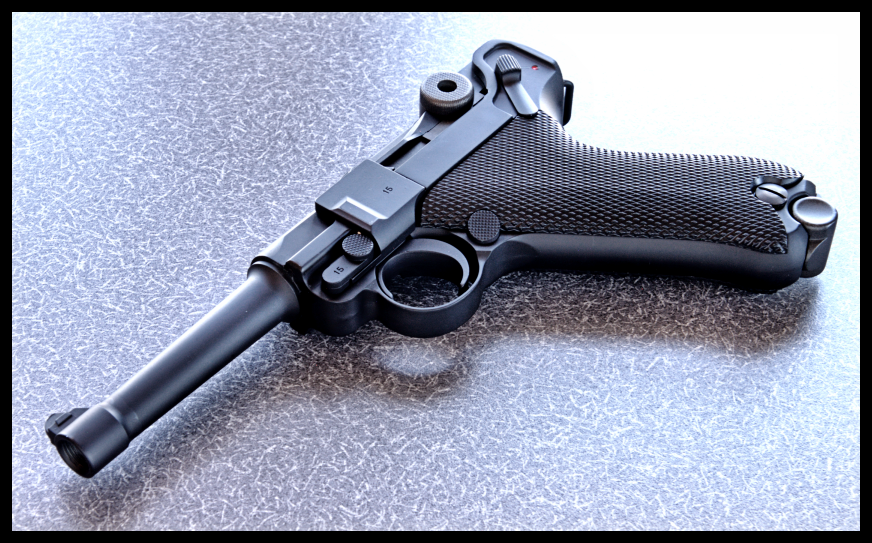
Introduction
The Luger has long been a popular and appreciated firearm since Georg Luger applied for the design patent on his handgun in 1898.
The weapon served the German military in both the world wars and was considered a prized war trophy by returning allied soldiers in both engagements.
From Wiki:
"The Luger uses a toggle-lock action, which utilizes a jointed arm to lock, as opposed to the slide actions of almost every other semi-automatic pistol. The mechanism is explained as follows: after a round is fired, the barrel and toggle assembly (both locked together at this point) travel rearward due to recoil. After moving roughly one-half inch (13 mm) rearward, the toggle strikes a cam built into the frame, causing the knee joint to hinge and the toggle and breech assembly to unlock. At this point the barrel stops its rearward movement (it impacts the frame), but the toggle and breech assembly continue moving (bending the knee joint) due to momentum, extracting the spent casing from the chamber and ejecting it. The toggle and breech assembly subsequently travel forward (under spring tension) and the next round from the magazine is loaded into the chamber. The entire sequence occurs in a fraction of a second.
In World War I, as submachine guns were found to be effective in trench warfare, experiments with converting various types of pistols to machine pistols (Reihenfeuerpistolen, literally "rapid-fire pistols") were conducted. Among those the Luger pistol (German Army designation Pistole 08) was examined; however, unlike the Mauser C96, which was converted in great numbers to Reihenfeuerpistole, the Luger proved to have an excessive rate of fire in full-automatic mode...."
"Though the Luger pistol was first introduced in 7.65x22mm Parabellum, it is notable for being the pistol for which the 9x19mm Parabellum cartridge was developed..."
"The P.08 was the usual sidearm for German Army personnel in both world wars, though it was being replaced by the Walther P38 starting in 1938. In 1930, Mauser took over manufacture of the P.08 (until 1943). The Swiss Army evaluated the Luger pistol in 7.65 mm P (.30 Luger in USA) and adopted it in 1900 as its standard sidearm, designated Ordonnanzpistole 00 or OP00, in 1900.
The Luger pistol was accepted by the German Navy in 1904, and in 1908 (as Pistole 08) by the German Army (chambered in 9x19mm Parabellum) replacing the Reichsrevolver. The Lange Pistole 08 or Artillery Luger had a stock and longer barrel, and sometimes used with a 32 round drum magazine (Trommelmagazin 08).
The United States evaluated several semi-automatic pistols in the late 1800s, including the Colt M1900, Steyr Mannlicher M1894, and an entry from Mauser. In 1900 the US purchased 1000 7.65 mm Lugers for field trials. Later, a small number were sampled in the then-new, more powerful 9 mm round. Field experience with .38 caliber revolvers in the Philippines and ballistic tests would result in a requirement for still-larger rounds.
In 1906, the US Army held trials for a large-caliber semi-automatic. After initial trials, DWM, Savage, and Colt were asked to provide further samples for evaluation. DWM withdrew for reasons that are still debated, though the Army did place an order for 200 more samples.
Although obsolete in many ways, the Luger is still sought after by collectors both for its sleek design, superlative accuracy, great durability, and by its connection to Imperial and Nazi Germany. Limited production of the P.08 by its original manufacturer resumed when Mauser refurbished a quantity of them in 1999 for the pistol's centenary. More recently, Krieghoff announced the continuation of its Parabellum Model 08 line with 200 examples at $15,950.00 apiece. The Luger was prized by Allied soldiers during both of the World Wars. Thousands were taken home during both wars, and are still in circulation today..."
In World War I, as submachine guns were found to be effective in trench warfare, experiments with converting various types of pistols to machine pistols (Reihenfeuerpistolen, literally "rapid-fire pistols") were conducted. Among those the Luger pistol (German Army designation Pistole 08) was examined; however, unlike the Mauser C96, which was converted in great numbers to Reihenfeuerpistole, the Luger proved to have an excessive rate of fire in full-automatic mode...."
"Though the Luger pistol was first introduced in 7.65x22mm Parabellum, it is notable for being the pistol for which the 9x19mm Parabellum cartridge was developed..."
"The P.08 was the usual sidearm for German Army personnel in both world wars, though it was being replaced by the Walther P38 starting in 1938. In 1930, Mauser took over manufacture of the P.08 (until 1943). The Swiss Army evaluated the Luger pistol in 7.65 mm P (.30 Luger in USA) and adopted it in 1900 as its standard sidearm, designated Ordonnanzpistole 00 or OP00, in 1900.
The Luger pistol was accepted by the German Navy in 1904, and in 1908 (as Pistole 08) by the German Army (chambered in 9x19mm Parabellum) replacing the Reichsrevolver. The Lange Pistole 08 or Artillery Luger had a stock and longer barrel, and sometimes used with a 32 round drum magazine (Trommelmagazin 08).
The United States evaluated several semi-automatic pistols in the late 1800s, including the Colt M1900, Steyr Mannlicher M1894, and an entry from Mauser. In 1900 the US purchased 1000 7.65 mm Lugers for field trials. Later, a small number were sampled in the then-new, more powerful 9 mm round. Field experience with .38 caliber revolvers in the Philippines and ballistic tests would result in a requirement for still-larger rounds.
In 1906, the US Army held trials for a large-caliber semi-automatic. After initial trials, DWM, Savage, and Colt were asked to provide further samples for evaluation. DWM withdrew for reasons that are still debated, though the Army did place an order for 200 more samples.
Although obsolete in many ways, the Luger is still sought after by collectors both for its sleek design, superlative accuracy, great durability, and by its connection to Imperial and Nazi Germany. Limited production of the P.08 by its original manufacturer resumed when Mauser refurbished a quantity of them in 1999 for the pistol's centenary. More recently, Krieghoff announced the continuation of its Parabellum Model 08 line with 200 examples at $15,950.00 apiece. The Luger was prized by Allied soldiers during both of the World Wars. Thousands were taken home during both wars, and are still in circulation today..."
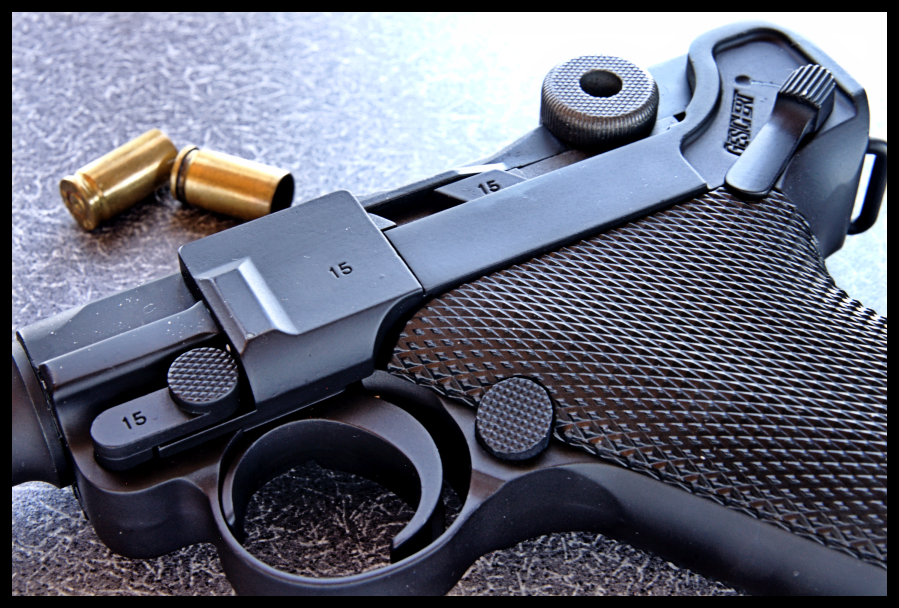
The Replica[/b]
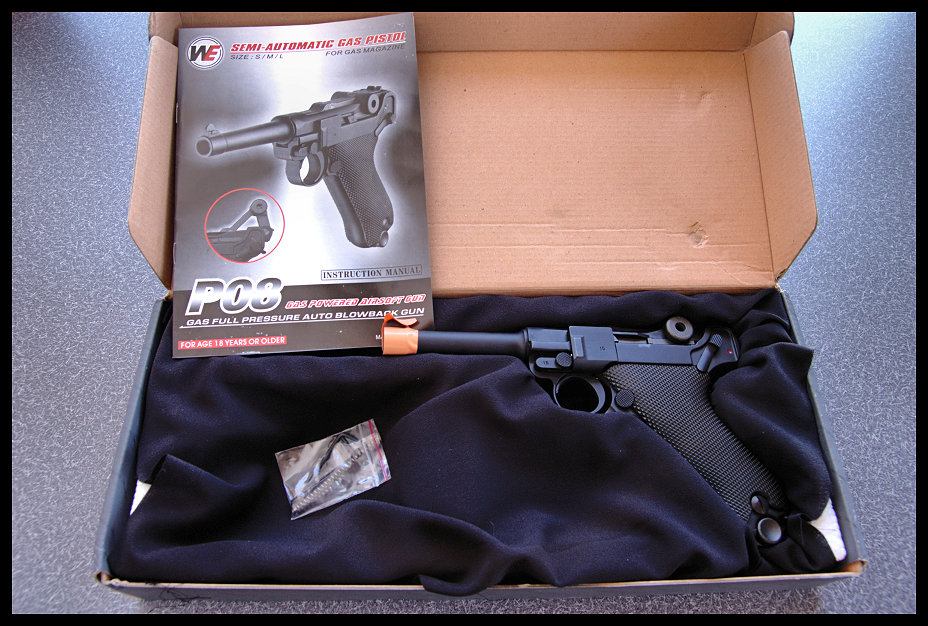
First off, I have to say that WE has come a long way in terms of product presentation and quality since the original 1911 clones we had a couple of years back- Not that the clone 'Hi-Capa' and 'Dragon' guns were not quality, but the packaging and presentation of the product itself by WE has improved a great deal in my opinion.

As you can see in the picture of the inside of the box, the gun ships with what appears to be an extra hammer spring and three assorted allen wrenches. An informative, easy to read 14 page manual is included.
The WE replica P08 Luger seems to be a pretty faithful clone in full metal of the Tanaka Works Luger. The Luger is certainly a popular weapon among Airsofters and news of WE producing this gun was met with a great deal of anticipation.
Let's see how WE has done on this icon of WWII sidearms.
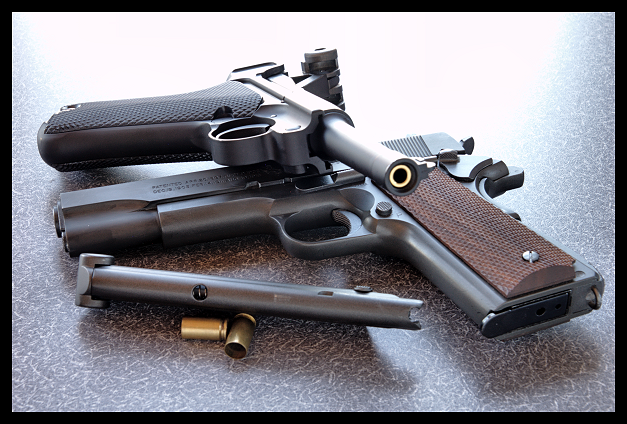
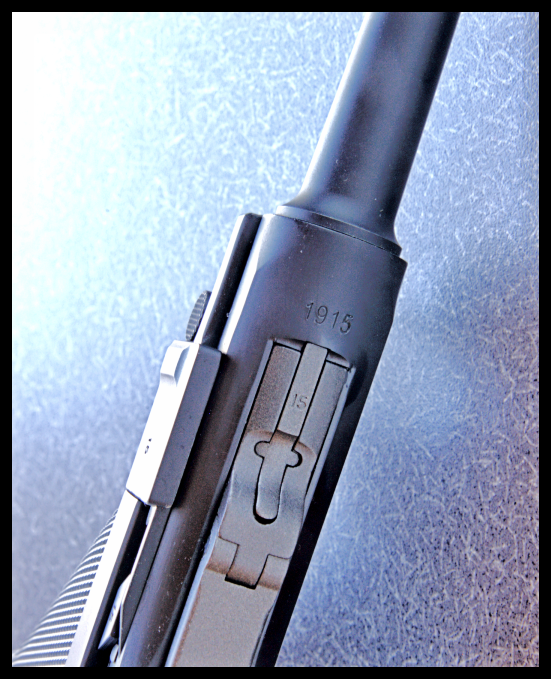
As you can see in the image with the 1911, WE has produced a unique magazine for the Luger. It is still basically the same magazine used in the Tanaka (BTW a licensed Western Arms ''Magna' blowback system), with the usual WE feed hole in the front of the magazine. Also visible in this picture is the bb barrel and muzzle of the P08. Here is one of my small annoyances with the otherwise spectacular WE offeriig: For some reason they have threaded the muzzle for a sliencer! However the large opening for the thread totally ruins the look (IMHO). The original Tanaka still wins in that respect.
The next image shows a closeup of the top of the gun and the markings that WE has included. They have decided to stamp the year '1915' there making this a WWI Luger. Since they did not replicate the other trademarks from the Tanaka, I wish they would have left the year off as well. Then at least I could have had an engraver do a '42' and 'byf' on the toggle to make it a WWII pistol. Oh well.
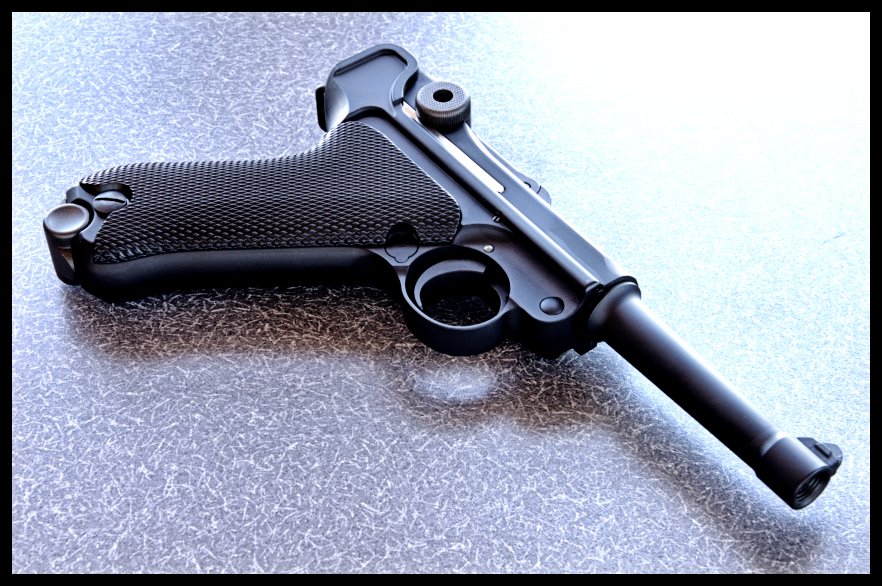
The Luger comes in the standard, matte black finish. The paint application is somewhat thin, and very minor use has already worn a couple of spots to expose the aluminum underneath. Rustoleum Flat Black 7578 is a good touch-up for those areas.
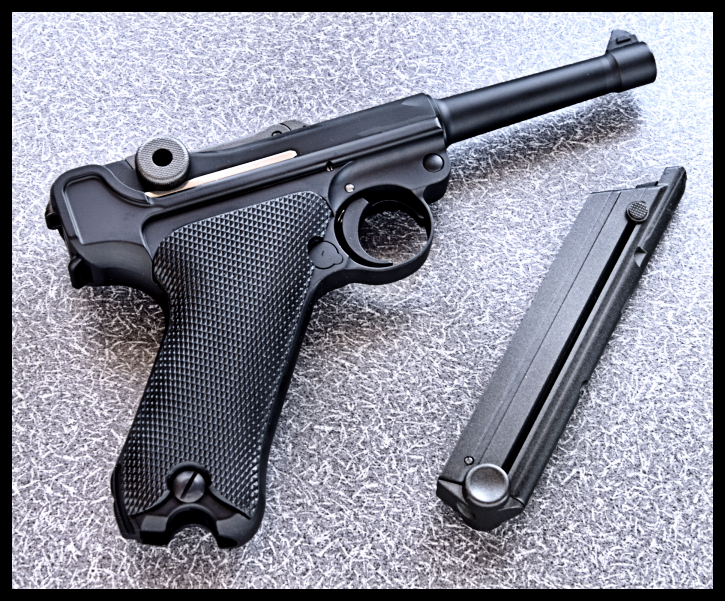
WE's Luger is an excellent replica of the venerable 9mm handgun. WWII enthusiasts have long dreamed of a full metal Luger and WE has definitely stepped up on this one. They have provided a much needed shot in the arm of period Airsoft war-gaming and at this price they position themselves to take full advantage of the increasing popularity of WWII era Airsoft games.
Stay tuned for Part II - Technical





